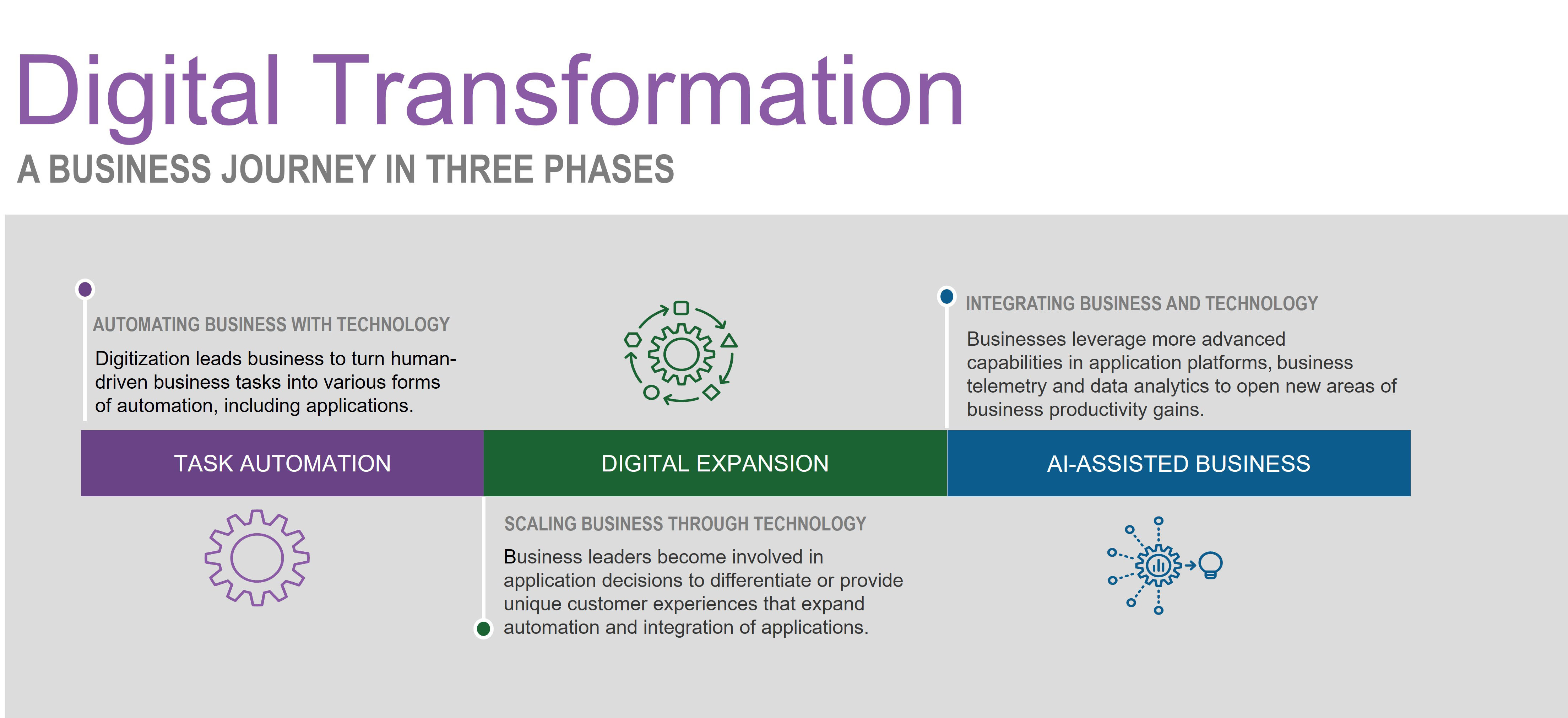Gefahr durch digitale Transformation: API-Ausbreitung


LORI MACVITTIE
Die digitale Transformation ist ein von Menschen vorangetriebener Geschäftsprozess . Und wie bei den meisten Reisen der Menschheit in der jüngeren Geschichte ist auch hier der Fortschritt auf die Technologie angewiesen.
Eigentlich ist diese Reise kein neues Phänomen. Unternehmen haben sich bereits vor der Erfindung der Computer durch Technologie verändert. Im Laufe der Zeit gab es viele durch die Technologie ermöglichte Transformationswellen. Vom Meißeln in Steintafeln über die Aufzeichnung von Transaktionen und Papierspuren bis hin zu digitalen Hauptbüchern ist Technologie die treibende Kraft hinter der Geschäftstransformation.

Die meisten Organisationen befinden sich bereits in der zweiten Phase und ein erheblicher Prozentsatz erkundet bereits die Vorteile der dritten Phase.
Der Einfluss von Organisationen, die sich auf die digitale Expansion konzentrieren, liegt in der Technologie, auf die sich IT- und App-Entwickler verlassen, um unterschiedliche Anwendungen, Systeme und Dienste zu einem nahtlosen, digitalen Erlebnis zusammenzufügen. Das heißt, Organisationen haben APIs übernommen.
Man kann davon ausgehen, dass APIs in allen Branchen erhebliche Auswirkungen haben werden, vom Bankwesen über den Einzelhandel bis hin zur Spielebranche. Unsere Untersuchungen und die darauf aufbauenden Modelle zeigen ein signifikantes Wachstum der APIs in den letzten Jahren und ein noch stärkeres Wachstum in den nächsten zehn Jahren.
Das Problem besteht darin, dass nicht alle neu bereitgestellten APIs geregelt, strukturiert oder dokumentiert sind. Auch die Einführung des Edge Computing hat zu einer noch stärkeren Nutzung von APIs geführt, da Unternehmen damit beginnen, Anwendungen und Cloud-Dienste auf eine zunehmende Anzahl (oft entfernter) Standorte zu verteilen.
Bedenken Sie, dass ein typisches Unternehmen APIs wahrscheinlich für viele Zwecke verwendet:
- Der Zugriff auf Infrastrukturdienste wie die Cloud (privat und öffentlich) und deren Bedienung erfolgt über APIs.
- Moderne Architekturen wie containernative Anwendungen basieren auf APIs für die dienstinterne Kommunikation sowie für die Betriebssteuerung und -konfiguration.
- Digitale Erlebnisse über das Internet oder Mobilgeräte basieren auf APIs, um alles von der einmaligen Anmeldung über die Authentifizierung bis hin zur Integration von Chat und sozialen Streams zu integrieren und Transaktionsfunktionen traditioneller Transaktionsanwendungen einzubinden .
- Bei der Automatisierung von CI/CD- und Bereitstellungspipelines kommen APIs zur Anwendung, um die Integration mit Systemen, Geräten und Diensten zu ermöglichen und so Entwicklungs- und Bereitstellungsprozesse nahtlos auszuführen .
Es gibt noch viele weitere Beispiele, aber schon anhand einiger weniger wird deutlich, wie schnell die Anzahl und der Standort von APIs wachsen.
Dieses Wachstum wird noch dadurch verschärft, dass sich Unternehmen künftig wie Unternehmen verhalten werden.
Unternehmen sind, unabhängig von ihrer Größe, eine Kombination aus Produkten und IT-Diensten, die im Auftrag der Geschäftseinheiten entwickelt werden, aus denen die Organisation besteht. Unternehmen sind naturgemäß in Silos organisiert und geben Informationen nur dann weiter, wenn sie unbedingt nötig sind. Mit der Expansion von Unternehmen wachsen auch die verschiedenen Geschäftseinheiten, Produktteams und Betriebsteams. Im Wesentlichen breitet sich das Geschäft aus . Da heutzutage jedes Team und jede Geschäftseinheit in erheblichem Maße auf APIs angewiesen ist, ist eine unausweichliche Ausbreitung der APIs die Folge.
Wir erkennen auch, dass ein neuer Ansatz erforderlich ist, um die Herausforderungen zu bewältigen, die sich aus der Ausbreitung von APIs ergeben, da sich vorhandene Lösungen auf die Herausforderungen innerhalb eines Clusters konzentrieren, d. h. auf die Herausforderungen bei der Verwaltung von APIs in einer Microservices-Umgebung. Der Umfang vorhandener Lösungen wurde noch nicht erweitert, um die Herausforderungen der API-Ausbreitung über Cluster hinweg zu bewältigen, d. h. zwischen Microservices-Umgebungen, die sich über Standorte, Geschäftseinheiten sowie Produkt- und Betriebsteams erstrecken.
In dieser Untersuchung des F5 Office of the CTO demonstriert Rajesh Narayanan, dass das Wachstum und die Verbreitung von APIs zu einer Wildwuchsentwicklung führen und zeigt einen Ansatz auf, der das daraus resultierende Chaos eindämmen könnte.